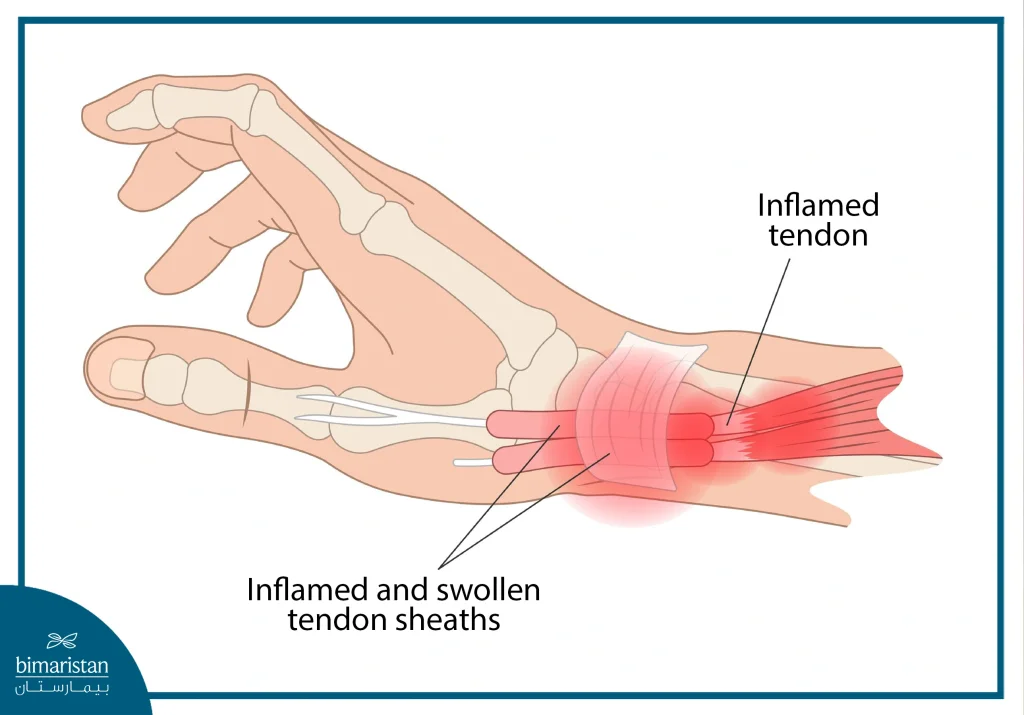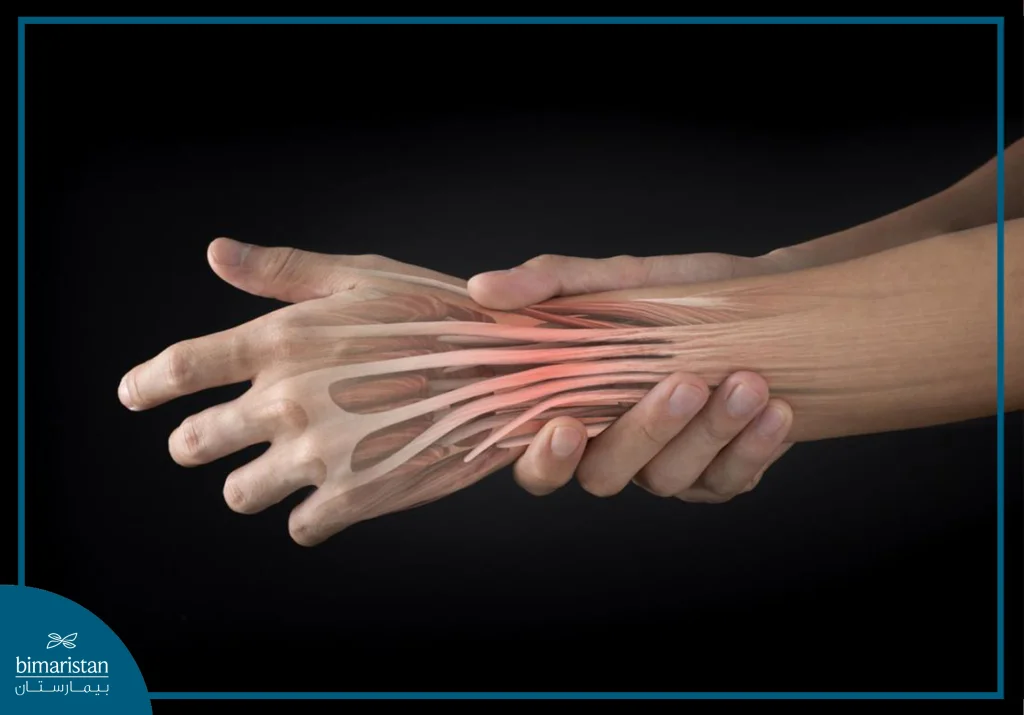When you have hand tendonitis, you may feel pain and burning when moving your affected hand, and the inflammation may progress to become continuous pain even at rest. Learn how to treat hand tendonitis.
Pain is one prominent symptom of hand tendonitis, but it’s not the only one. Often, individuals with tendonitis experience numbness or tingling when moving the wrist or all five fingers, especially the thumb, due to the presence of an important tendon called the “de Quervain’s tendon,” which may become inflamed.
If your work requires frequent use of your hands, such as writing or drawing, or if you’re a homemaker who performs many household chores with your hands, you may be more prone to developing hand tendonitis. Excessive stress on the tendons can lead to inflammation of the tendons surrounding the hand and wrist. Follow along to learn more about this condition and its treatment.
Overview of hand tendonitis
Tendons are white cords that connect bones to muscles to ensure coordinated movement and protect joints from injury during movement.
Six tendons in the wrist connect the muscles and bones of the hand. Sometimes, due to excessive stress on these tendons or severe injury (such as sudden twisting), one of the tendons becomes inflamed, causing various signs and symptoms, including wrist and hand pain and other annoying symptoms that we’ll mention later.
Inflammation can affect the sheath surrounding the tendon and later spread inflammation to the tendon itself. One of the most susceptible tendons to inflammation in the hand is the thumb tendon and the wrist tendon.
Hand tendonitis doesn’t differ much from other tendon inflammations in the body, such as shoulder tendonitis or knee tendonitis, in terms of causes, symptoms, and treatment.
Symptoms of hand tendonitis
Typically, individuals with tendonitis experience one or more of the following symptoms and signs:
- Hand and wrist pain that worsens with movement and decreases with rest
- The pain may intensify in advanced stages of inflammation and spread to wider areas of the hand
- Difficulty performing specific movements such as opening jars or rotating the doorknob and lifting heavy objects overhead
- Stiffness or rigidity in the joint and hearing a popping sound (cracking) when moving the hand
- Swelling around the wrist and hand or at the base of the fingers
- Difficulty bending the fingers
- Increased hand numbness (tingling sensation)
Causes of hand tendonitis
As mentioned earlier, hand tendonitis usually occurs when the tendons of the wrist and hand are repeatedly and continuously stressed for long periods. Excessive hand use is often seen in specific professions (such as writers, drivers, and painters) or in some athletes (golfers or tennis players), and it’s also observed in homemakers.
Excessive loading leads to inflammation and swelling in the sheath surrounding the tendon. This makes it difficult for the tendons to move and slide around the sheath, resulting in pain when moving the affected hand.
Severe injuries to the hand can cause tearing and inflammation of the joint tendons of the hand.

Diagnosis of hand tendonitis
The doctor will ask the patient about their symptoms in detail and then conduct some tests, such as asking the patient to move their hand or wrist in different positions while noting any increase in hand pain during certain movements. Additionally, the doctor will examine the hand and fingers to look for any inflammatory signs such as swelling and redness.
When the specialist suspects hand tendonitis, they may resort to one of these tests to confirm the diagnosis, including:
X-ray imaging
This test helps rule out other problems that may cause similar symptoms to a tendon injury, especially bone problems such as fractures.
Ultrasound imaging
Ultrasound helps detect inflammatory joint diseases such as rheumatoid arthritis and gout, among other joint diseases that may have symptoms similar to tendonitis.
How to treat hand tendonitis
When hand tendonitis is not properly treated, it may progress to a chronic condition that causes difficulty in hand movement for the patient. Therefore, it is preferable to consult a doctor quickly when feeling signs that may indicate inflammation in one of the tendons of your hand so that your doctor can determine an appropriate treatment plan for the inflammation.
There are several methods available to treat hand tendonitis. The doctor may prescribe pain relievers and anti-inflammatory drugs in the early stages of tendon inflammation. However, your doctor may recommend surgery in more severe cases of inflammation, which may be accompanied by tearing or cutting of the tendon. Let’s discuss more details about the methods used to treat tendon inflammation, including:
Read more about: Hand tremor Learn about the causes, treatment and prevention
Rest and avoiding stressful hand activities
The most important step in treating and alleviating the symptoms of hand tendonitis is resting your hand from strenuous activities and continuous movement. Stop working and take a break when you feel pain in one of your hands, and it’s best to avoid lifting heavy weights or any strenuous activity for the hand tendons.
Applying ice to the swollen and painful area of your hand also helps reduce inflammation and relieve tendon pain, in addition to the important role of physical therapy in improving range of motion and relieving hand tendon pain. Read more about the benefits of physiotherapy.
Cream for treating hand tendonitis
Doctors usually prescribe medications and creams to alleviate the severity of the pain suffered by patients with wrist and hand tendonitis. These medications include nonsteroidal anti-inflammatory drugs, such as ibuprofen or acetaminophen, that may be given orally or as creams that are easily applied to the skin, as well as many other pain relievers.
Treatment of hand tendonitis with herbs
Although the effectiveness of herbs in treating tendonitis has not yet been proven, their effect is often limited to combating and reducing inflammation and pain. Therefore, it’s not possible to rely solely on herbs for the treatment of tendonitis; instead, they should be combined with medications or other treatment methods.
Among the herbs used to manage and treat tendonitis are:
- White willow
- Turmeric
- Garlic
- Cabbage leaves
- Rosemary
Read about:
Diagnosis and Treatment of Carpal Tunnel Syndrome in Turkey

Repairing hand tendon tears
In advanced stages of hand tendonitis or due to severe injury, the tendon may tear and cut, necessitating surgical intervention to repair the tear.
There is no need to worry as this procedure is simple and is usually performed in an outpatient setting and does not require general anesthesia but rather local anesthesia. You can remove the surgical stitches in less than two weeks after the surgery.
In conclusion, hand tendonitis is a common condition among individuals with excessive hand use, such as those in professions that require it, such as homemakers, golfers, and tennis players. This problem causes several symptoms, most notably hand pain and difficulty moving it, with a sensation of burning and numbness in the hand. As for treatment methods, resting the hand is considered the most important step, and pain-relieving and anti-inflammatory creams can also be used. Surgical intervention remains an option of last resort in case the previous methods fail to alleviate the severity of tendonitis symptoms complained of by the patient or in case of tendon tear and cutting.
Sources:



